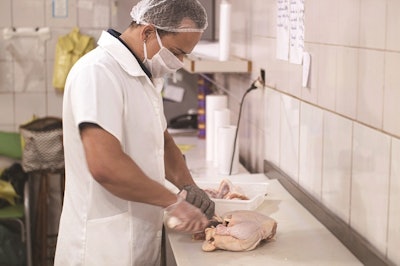
The Brazilian poultry industry is optimistic that 2022 will be another record-breaking year. As 2021 draws to a close, Brazilian chicken meat production and exports are expected to reach new highs, and producers are confident that these successes will be repeated next year.
Speaking at a press conference in late September 2021, Ricardo Santin, president of industry association the Brazilian Association of Animal Protein (ABPA), forecast that Brazil’s broiler meat production would reach 14.4 -14.7 million metric tons next year. Exports are also forecast to be higher but will increase at a more moderate rate, forecast to rise by 3.5% to 4.65 million tons, than in 2021.
Next year should build on 2021’s successes at home and abroad and, the industry believes, will see some of 2021’s difficulties, for example high feed costs, starting to be overcome.
Demand for chicken meat in Brazil’s home market is thought to have grown by 6.5% this year and, looking ahead, Santin said: “Advances in vaccination, in addition to the improvements in the economy, support an outlook for continued demand for poultry, pig and egg products in the national market”.
Broiler industry expands in 2021
In 2020, Brazil recorded a moderate increase in production, however, 2021, while weaker in the second half, has witnessed a much stronger performance.
The country is expected to end the year with broiler meat output standing at between 14.1 and 14.3 million metric tons – an increase of 3.5% and a new record. Exports this year are also expected to reach an all time high, rising by around 7.5% to between 4,500 and 4,550 metric tons.
Feed difficulties waning
Brazil, like other poultry producing countries, has not been immune to the problems that have emerged as the effects of the pandemic have waned.
Feed, and other input costs have risen sharply. In the case of corn, the first quarter saw corn prices reach record highs, in part caused by regional droughts, prompting the government to remove the import duties normally imposed on corn imports coming from beyond trade grouping Mercosur.
Santin noted that this government action resulted in costs stabilizing and speculation ending and has been particularly beneficial for smaller producers. Forecasts for the next corn harvest are positive as are forecasts for alternatives, which should help the industry over the year ahead. Looking forward, the industry believes that it can now see light at the end of the tunnel.
Despite this stabilization, the industry believes that there will have to be what it terms a rebalancing in the price of chicken. Santin noted that production costs had risen by over 44% over the preceding 12 months. This has reduced margins and, although consumer prices have risen, they will have to rise further. These price rises, however, will not be unique to the poultry industry and, as the cost of animal protein increases, consumers are more likely to opt for cheaper options, particularly chicken. This year, per capita chicken meat consumption is expected to reach 46 kg, rising to 47.5 kg in 2022.

Broiler meat exports to remain strong
Where trade is concerned, China now accounts for 15% of Brazil’s total chicken meat exports. Over the first 8 months of this year, shipments to China were down by 6% and this contraction is expected to continue into the new year, although China will remain the main destination for Brazilian exports with strong demand set to continue in the near-term.
New markets, however, are firmly on Brazil’s radar. Santin noted that shipments to the U.K. rose by 36% between January and August 2021 and should rise further still next, if government discussions to raise quotas prove successful.
More generally, the industry expects to benefit as more countries complete their vaccination roll-outs economies re-open following COVID-19 lockdowns.
Need for infrastructure investment
Growing demand for exports, however, may cause its own problems. Santin noted that, according to the US Department of Agriculture, Brazil’s shipments of food to the world are expected to grow by 41% over the next five years. Where poultry and pig meat are concerned, this would equate to an additional 7.5 million metric tons.
Eighty percent of the poultry industry’s exports are sent by sea and, he noted, without investment in ports the industry would not be able to fully respond to growing demand for its products.


















